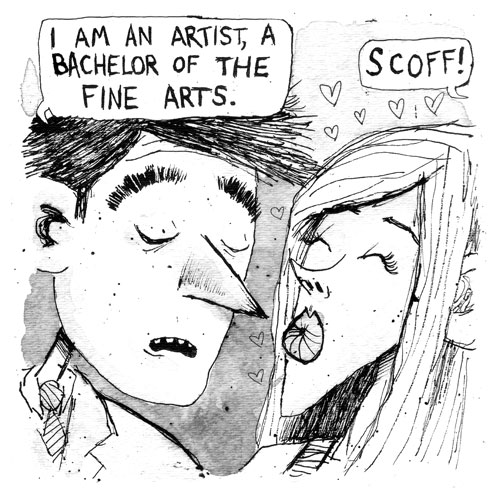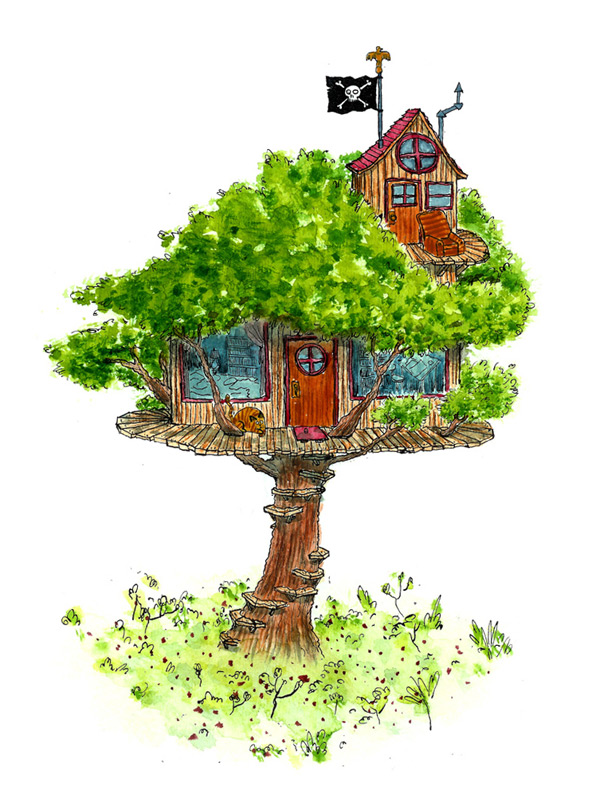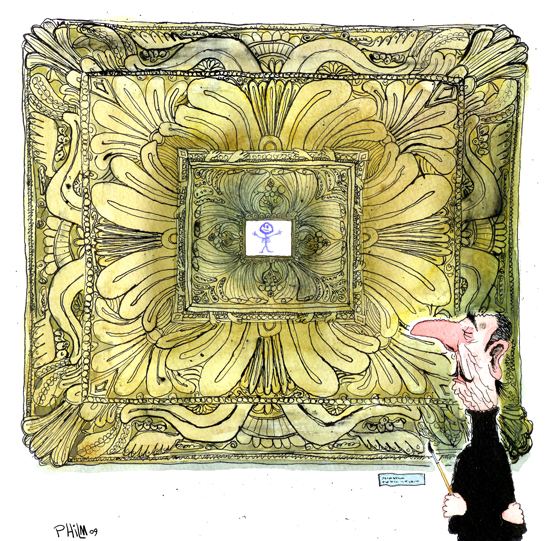
My job is to sit at home and draw pictures all day.
I'm an illustrator and a cartoonist. My work has appeared in magazines, newspapers, books, art galleries, on television and on t-shirts. I've contributed to MAD Magazine. I spent a large chunk of time this past year developing a project for Cartoon Network. I'm currently working on three different book projects simultaneously while also juggling a plethora of small illustration jobs. And it's awesome. I love what I do. I have the best job in the world.

I don't know about you guys, but I HATED having to wake up early for school every day. I hated having to sit at a desk in a boring classroom all day. I hated doing math problems. I still hate doing math problems.

I remember going into the newspaper office with my dad when I was a kid. It was exciting, but it also brought on a harsh realization: My dad woke up really early every day to go into an office and sit at a desk. Sure, there's more to being a journalist than sitting at a desk, but that's the part that I got to see. And I HATED the thought of growing up and getting a job where i'd have to wake up early and go into an office and sit at a desk. For all I knew they might make adults do math problems too.
So I decided at a very young age to pursue a career where I'd get to stay home and draw pictures in my underwear every day. I decided I wanted to be a cartoonist or an illustrator (or both).

It wasn't just my desire to avoid having to wake up early to sit at a desk in an office or the desire to avoid doing math problems that made me want to be an illustrator or cartoonist. I also LOVED to draw. Some of the earliest memories I have are of sitting on the floor and drawing. I remember watching Sesame Street and attempting to draw all the different Muppets in each episode. I remember drawing monsters and haunted castles with my brothers. I remember creating and drawing my own super heroes and aliens and cartoon characters. I remember drawing Godzilla and Ninja Turtles. Drawing was (and still is) one of my favorite things to do. It was (and still is) extremely fun.
All through school I drew. I drew in every class. I never got any better at math but I sure got better at drawing. I went on to college with a portfolio based visual art scholarship.
When I finished college I found myself spewed out into "the real world" with a degree in illustration, which is basically just a really expensive piece of paper that says "this guy can draw pretty cool pictures." An illustration degree typically won't help you land a full time job. There aren't very many 9-5 day jobs out there for illustrators. Heck there weren't that many 9-5 jobs for anyone at the time. I graduated in 2007. You may remember that this happened right around that time.

But of course I didn't really want a 9-5 job. I wanted to get paid to hang out at home in my undies drawing pictures all day. I wanted to be a freelance illustrator or a cartoonist. But a career as a freelance illustrator / cartoonist isn't something you can just waltz into. It can take years to get to a point where you're able to fully support yourself as a freelancer. I wasn't a dummy, I knew it would take a long time and a lot of hard work. I also knew that I needed to make money somehow in the meantime. So I took on part-time jobs and tackled as much freelance illustration work as I could get my hands on in my spare time. A lot of the part-time jobs I had in the first few years after college were terrible, soul-crushing jobs.

One of the least soul-crushing part-time jobs I had after college was teaching art and drawing to elementary school children as part of an after-school program. When I signed up for the job I was told I'd be working with older kids, probably eleven or twelve-year-olds. But when I showed up on the first day they stuck me in a classroom full of first graders, which are mostly six and seven-year-olds. If you've ever worked with young kids, I'm sure you'll agree that six-year-olds are maniacs. Most of my time at this job was spent begging the kids not to throw things, not to stand on tables, not to hit each other, not to scream at the top of their lungs, not to remove their clothing, not to empty the contents of the toy shelf onto the floor.... but on the occasions that I was able to get the kids to sit still for five minutes they turned into UNSTOPPABLE DRAWING MACHINES!
Pretty much every kid loves to draw. We all do it when we're young. I don't have any official scientific data to back this up, but I'd bet money that something like nine out of ten six-year-olds enjoy drawing. Like I said, it's fun!
The thing that really struck me, working with a classroom full of six-year-olds, was that kids draw without any reservations or inhibitions. They just have fun and are excited about putting their ideas down on paper, about making something tangible with just a marker and their imagination. And if they're young enough, it doesn't matter how primitive or messy their drawings might look. When it comes to drawing, kids are FEARLESS.
But at some point in life most people stop drawing. Once again, I don't have any official scientific data to back this up, but I'd bet money that something like eight or nine out of ten adults will tell you that they "can't draw." Most adults are extremely reluctant to even attempt drawing. At some point in life most people, for some reason, flip from having fun and enjoying the act of drawing to being afraid to even try. They become convinced that drawing is something that they simply aren't capable of.

Why does this happen? How can people, almost universally, switch from thinking drawing is fun and exciting, from doodling without reservations or inhibitions, to being convinced that they "can't draw" or being afraid of even trying? This seemed insane to me, watching a room full of six-year-olds doodle their little hearts out.
I suppose the most likely answer is that people become self-conscious. Everyone becomes more aware and critical of themselves and their abilities as they grow up. Everyone experiences self-doubt. Even great artists can be filled with self-doubt.


I don't mean to disparage graphic designers! I have an enormous amount of respect for designers of all kinds. They do things that make me think "how the heck did they do that...." And I'm not anti-computers either! Computers are amazing tools, I use use Photoshop heavily at various points in my process for most projects. And though I'm primarily an illustrator, I have a lot in common with designers: both of our jobs, when boiled down, is to solve visual problems. Maybe it's creating an illustration for the cover of a book, maybe it's designing a user interface for a mobile application, maybe it's arranging text and images and colors and shapes to create a menu for a pizza place. At the end of the day, we're all trying to solve a visual problem. We have to find a way to convey a message or a feeling or a piece of information in a readable, interesting, aesthetically pleasing way.
I like to think of ideas as nebulous clouds of fog. When an illustration job falls into my lap, or maybe when I have to paint something for a gallery show, a foggy nebula of an idea immediately begins to float around in my head. It's vague, it's murky... I might have some sense of what direction I want to go in or maybe there's a color scheme or a certain feeling swirling around in the fog, but it's still shapeless and uncertain.
The moment I begin doodling, that vague, murky, idea magically becomes more than just a nebulous fog. The doodles might be no more than messy scribbles, still extremely vague and ambiguous. But that shapeless idea fog transmutes into something real, something tangible. It becomes a seed for something. And I like to plant a lot of seeds! Most of the stuff I draw, even the extremely detailed, meticulous, intricate, complicated drawings... it all starts out as sloppy, messy scribbles. Being able to throw inhibitions out the window (like a six-year-old) and just scribble... that is always the first and most important part of my process as a visual problem solver, after any initial research that might be required, of course.

I like to walk to the coffee shop around the corner from my apartment with a stack of paper and a pencil. I don't go home until every sheet of paper is completely filled with scribbles and doodles. By doodling I'm planting a seed. The more I doodle, the more that seed is going to grow. A lot of the ideas that spill out of my head an onto the paper might be pretty bad. A lot of them are usually mediocre. But usually there are a few that I like, hopefully even a few that I love. I take the good ones and flesh them out a bit more. They're still scribbly and messy, but the foggy ideas become clearer, more palpable. This is an incredibly cheesy thing to say, so please forgive me, but a tree grows from the collection of scribbles, from the seed I planted. Once that tree starts to grow, it's pretty easy to figure out which branches are the strongest. And the strongest branch is where you build your tree fort. That's where you go with your idea.

WAIT, NO. Nobody dies! Nobody will die if you draw something and it looks like crap. The police won't come and say "jeez, that's a pretty terrible drawing of a dinosaur with a rocket launcher attached to it's head, I'm afraid we're going to have to drag you off to art jail." Nothing bad happens when you make a bad drawing. The absolute worst thing that happens is that you learn something. You grow a little bit. You get better at drawing.
I know most of you are not professional illustrators. Maybe you're a graphic designer or maybe you're a person who at the age of eight decided to forsake the act of drawing and become an accountant. It doesn't matter who you are. It's stupid to be afraid of drawing or to believe that you "can't draw." That's ridiculous. You might not remember it, but when you were a kid you drew and you loved it. You didn't care if the drawings were good. You drew without fear! You were fearless! Why are you afraid of it now?
Drawing is fun. I encourage everyone to doodle, not just aspiring illustrators and designers with MacBook tunnel vision. Drawing is one of the most human things you can possibly do. Doodling is extremely healthy. It's okay to scribble. It's okay if your skills aren't on the same level as your vision (they'll catch up if you stick with it). It's okay if you don't have the skills to draw anything more difficult than simple shapes. It's okay to make really bad drawings. It's okay to draw like a six-year-old.
